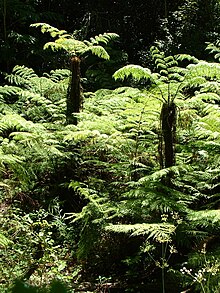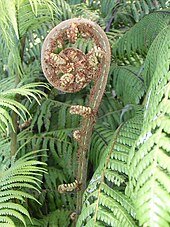
Pteris (brake) is a genus of about 300 species of ferns in the subfamily Pteridoideae of the family Pteridaceae. They are native to tropical and subtropical regions, southward to New Zealand, Australia, and South Africa, north to Japan and North America. 78 species are found in China. Some species of Pteris have considerable economic and ecological value, such as Pteris multifida, Pteris ensiformis, Pteris vittata can be used for ornamental purposes; as a hyperaccumulator, Pteris multifida and Pteris vittata can be used to control soil pollution.
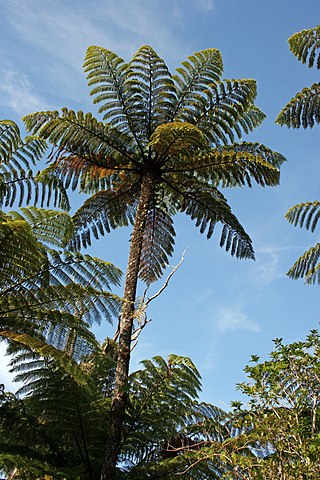
Cyathea is a genus of tree ferns, the type genus of the fern order Cyatheales.

Microsorum is a genus of ferns in the family Polypodiaceae, subfamily Microsoroideae, according to the Pteridophyte Phylogeny Group classification of 2016 (PPG I). The species are tropical. Like most ferns, they grow from rhizomes, rather than roots. The genus name is often misspelled "Microsorium" or "Microsoreum". It includes some species that are lithophytic rheophytes.

Sphaeropteris is a genus of tree fern in the family Cyatheaceae. It has been treated as a subgenus within the genus Cyathea, but is accepted in the Pteridophyte Phylogeny Group classification of 2016.
Gymnosphaera biformis, synonyms Alsophila biformis and Cyathea biformis, is a species of tree fern native to New Guinea and the Maluku Islands, where it grows against trees in mossy forest and rain forest at elevations of 850–2200 m. The climbing trunk is very thin, only 1–2 cm in diameter, but can reach 3 m in height. The apex of the trunk is covered in scales. Two types of fronds are produced, simple pinnate fronds, which are sterile, and bipinnate fronds, which may be fertile. The stipe is smooth, glossy and very dark, almost to the point of being black. It is covered at the base with long, very dark scales that have a pale margin. Fertile pinnules are distinctly stalked and lobed. Sori occur in four pairs per pinnule lobe and lack indusia.
Gymnosphaera is a genus of tree ferns in family Cyatheaceae.

Dennstaedtia is a mostly tropical and subtropical genus of ferns described as a genus in 1801. hayscented fern, or cup ferns, are common names for some species in this genus. Its best-known member is probably the temperate North-American hay-scented fern, Dennstaedtia punctilobula, which forms extensive clonal ground-cover colonies on level surfaces in the Appalachian area.

Bolbitis is a genus of ferns in the family Dryopteridaceae, subfamily Elaphoglossoideae, in the Pteridophyte Phylogeny Group classification of 2016.

Hymenophyllum is a genus of ferns in the family Hymenophyllaceae. Its name means "membranous leaf", referring to the very thin translucent tissue of the fronds, which gives rise to the common name filmy fern for this and other thin-leaved ferns. The leaves are generally only one cell thick and lack stomata, making them vulnerable to desiccation. Consequently, they are found only in very humid areas, such as in moist forests and among sheltered rocks. They are small and easy to overlook.
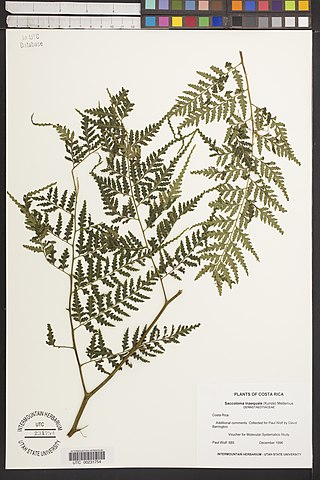
Saccoloma is a fern genus in family Saccolomataceae. It is the only genus in the family in the Pteridophyte Phylogeny Group classification of 2016, but further investigation is needed. It is pantropical and its species are found in wet, shaded forest areas. Saccoloma species are characterized by an omega-shaped (Ω) vascular bundle in the cross-sections of their petioles. The common name soralpouch fern is used for Saccoloma.

Tectaria is a genus of fern in the family Tectariaceae, according to the Pteridophyte Phylogeny Group classification of 2016. Halberd fern is a common name for species in this genus.
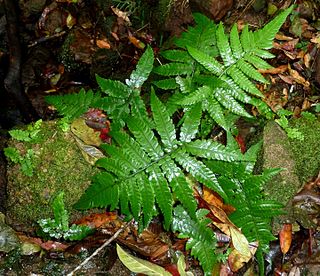
Deparia is a genus of ferns. The Pteridophyte Phylogeny Group classification of 2016 places the genus in the family Athyriaceae, although other sources include it within an expanded Aspleniaceae or Woodsiaceae.

Lindsaea, common name necklace fern, is a genus of around 180 species of fern, 15 of which reach Australia. The name is in honour of surgeon John Lindsay of Jamaica. The genus is sometimes spelt Lindsaya.

Christella is a genus of around 70-80 species of ferns in the subfamily Thelypteridoideae of the family Thelypteridaceae in the Pteridophyte Phylogeny Group classification of 2016. Other sources sink Christella into a very broadly defined genus Thelypteris. The genus was named after Konrad H. Christ, a Swiss botanist. The distribution of these plants is mostly in the tropics and sub tropical areas. An Australian example is C. dentata.
Pronephrium is a genus of ferns in the family Thelypteridaceae in the family Thelypteridaceae, subfamily Thelypteridoideae, in the Pteridophyte Phylogeny Group classification of 2016. Other sources sink Pronephrium into a very broadly defined genus Thelypteris. Some species were split off into the genera Abacopteris, Grypothrix and Menisciopsis in 2021 as a result of a phylogenetic study of the family Thelypteridaceae.

Amauropelta is a genus of ferns in the family Thelypteridaceae, subfamily Thelypteridoideae, in the Pteridophyte Phylogeny Group classification of 2016. Other sources sink the genus into a very broadly defined genus Thelypteris.

Coryphopteris is a genus of ferns in the family Thelypteridaceae, subfamily Thelypteridoideae, in the Pteridophyte Phylogeny Group classification of 2016.
